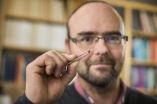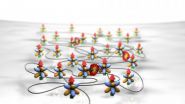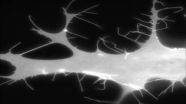(Press-News.org) Tropical Cyclone Lusi reached hurricane force as NASA's Aqua satellite passed overhead early on March 12.
The Moderate Resolution Imaging Spectroradiometer or MODIS instrument aboard NASA's Aqua satellite captured a visible image of Tropical Cyclone Lusi that showed the storm's western quadrant affecting Vanuatu on March 12 at 02:05 UTC. In the MODIS image, Lusi had the distinct comma shape of a mature tropical cyclone, however no eye was visible. However, animated multispectral satellite imagery does show a ragged eye with tightly curved bands of thunderstorms wrapping into it.
At 11 a.m. EDT/1500 UTC on March 12, the Vanuatu Meteorological Service's forecast noted "Heavy rain and thunder with flooding associated with [Tropical Cyclone] Lusi will continue to affect Shefa and Tafea provinces. Gale to storm clockwise winds for Shefa and Tafea province, while fresh trades prevail elsewhere." A Severe Weather Warning remained in effect that noted showers and thunderstorms with heavy rainfall is expected over Northern and Central Islands with inland winds of 40km/h to 50km/h. Flash flooding is also expected over low lying areas and areas close to the river banks. For updates from the Vanuatu Met Service, visit: http://www.meteo.gov.vu.
On March 12 at 0900 UTC/5 a.m. EDT, Tropical Cyclone Lusi's maximum sustained winds were at 65 knots/74.8 mph/120.4 kph. Tropical-storm-force winds extend out about 80 nautical miles/92.0 miles/148.2 km from the center. Lusi was centered near 18.2 south latitude and 171.5 east longitude, about 395 nautical miles/454.6 miles/ 731.5 km west of Suva, Fiji. Lusi is moving to the southeast at 13 knots/14.9 mph/24.0 kph.
The Joint Typhoon Warning Center forecast calls for Lusi to intensify to 75 knots and then start to weaken on March 13 as it continues moving southward. Lusi is then expected to start transitioning into an extra-tropical storm.
INFORMATION:
NASA sees Tropical Cyclone Lusi over Vanuatu
2014-03-12
ELSE PRESS RELEASES FROM THIS DATE:
Sound trumps meaning in first language learning
2014-03-12
(Washington, DC) – A new study reveals that four-to-seven-year-old children rely on the sounds of new nouns more than on their meaning when assigning them to noun classes, even though the meaning is more predictive of noun class in the adult language. This finding reveals that children's sensitivity to their linguistic environment does not line up with objective measures of informativity, highlighting the active role that children play in selecting the data from which they learn language.
The study, "Statistical Insensitivity in the Acquisition of Tsez Noun Classes," ...
Good vibes for catalytic chemistry
2014-03-12
SALT LAKE CITY, March 12, 2014 – University of Utah chemists discovered how vibrations in chemical bonds can be used to predict chemical reactions and thus design better catalysts to speed reactions that make medicines, industrial products and new materials.
"The vibrations alone are not adequate, but combined with other classical techniques in physical organic chemistry, we are able to predict how reactions can occur," says chemistry professor Matt Sigman, senior author of the study in the Thursday, March 13, issue of the journal Nature.
"This should be applicable ...
IRX3 is likely the 'fat gene'
2014-03-12
Mutations within the gene FTO have been implicated as the strongest genetic determinant of obesity risk in humans, but the mechanism behind this link remained unknown. Now, an international team of scientists has discovered that the obesity-associated elements within FTO interact with IRX3, a distant gene on the genome that appears to be the functional obesity gene. The FTO gene itself appears to have only a peripheral effect on obesity. The study appears online March 12 in Nature.
"Our data strongly suggest that IRX3 controls body mass and regulates body composition," ...
Building new drugs just got easier
2014-03-12
LA JOLLA, CA—March 12, 2014—Scientists at The Scripps Research Institute (TSRI) have developed a method for modifying organic molecules that significantly expands the possibilities for developing new pharmaceuticals and improving old ones.
"This is a technology that can be applied directly to many medicinally relevant compounds," said Jin-Quan Yu, a professor in TSRI's Department of Chemistry and the senior author of the new report, which appears in Nature March 13, 2014.
The innovation makes it easier to modify existing organic compounds by attaching biologically active ...
Water-rich gem points to vast 'oceans' beneath the Earth: UAlberta study
2014-03-12
A University of Alberta diamond scientist has found the first terrestrial sample of a water-rich gem that yields new evidence about the existence of large volumes of water deep beneath the Earth.
An international team of scientists led by Graham Pearson, Canada Excellence Research Chair in Arctic Resources at the U of A, has discovered the first-ever sample of a mineral called ringwoodite. Analysis of the mineral shows it contains a significant amount of water—1.5 per cent of its weight—a finding that confirms scientific theories about vast volumes of water trapped 410 ...
Quantum chaos in ultracold gas discovered
2014-03-12
The team of Francesca Ferlaino, Institute for Experimental Physics of the University of Innsbruck, Austria, has experimentally shown chaotic behavior of particles in a quantum gas. "For the first time we have been able to observe quantum chaos in the scattering behavior of ultracold atoms," says an excited Ferlaino. The physicists used random matrix theory to confirm their results, thus asserting the universal character of this statistical theory. Nobel laureate Eugene Wigner formulated random matrix theory to describe complex systems in the 1950s. Although interactions ...
Key heart-failure culprit discovered
2014-03-12
SAN DIEGO, Calif., March 12, 2014 - A team of cardiovascular researchers from Sanford-Burnham Medical Research Institute (Sanford-Burnham), the Cardiovascular Research Center at Icahn School of Medicine at Mount Sinai, and the University of California, San Diego have identified a small but powerful new player in the onset and progression of heart failure. Their findings, published in the journal Nature on March 12, also show how they successfully blocked the newly discovered culprit to halt the debilitating and chronic life-threatening condition in its tracks.
In the ...
Protein key to cell motility has implications for stopping cancer metastasis
2014-03-12
VIDEO:
Aberrant filopodia are induced by co-expression of fluorescently labeled Cdc42 and non-fluorescent IRSp53. Fluorescence shows the cell shape, because Cdc42 localizes to the plasma membrane.
Click here for more information.
PHILADELPHIA - "Cell movement is the basic recipe of life, and all cells have the capacity to move," says Roberto Dominguez, PhD, professor of Physiology at the Perelman School of Medicine, University of Pennsylvania. Motility – albeit on a cellular spatial ...
Countering the caregiver placebo effect
2014-03-12
How do you know that your pet is benefiting from its pain medication? A new clinical trial design from North Carolina State University researchers could help overcome pet owners' unconscious observation bias and determine whether the drugs they test are effective.
When animals are recruited for clinical trials, particularly for pain medications, researchers must rely on owner observation to determine whether the medication is working. Sounds simple enough, but as it turns out, human and animal behavior can affect the results.
All clinical trials have a "control" ...
'Ultracold' molecules promising for quantum computing, simulation
2014-03-12
WEST LAFAYETTE, Ind. – Researchers have created a new type of "ultracold" molecule, using lasers to cool atoms nearly to absolute zero and then gluing them together, a technology that might be applied to quantum computing, precise sensors and advanced simulations.
"It sounds counterintuitive, but you can use lasers to take away the kinetic energy, resulting in radical cooling," said Yong P. Chen, an associate professor of physics and electrical and computer engineering at Purdue University.
Physicists are using lasers to achieve such extreme cooling, reducing the temperature ...






